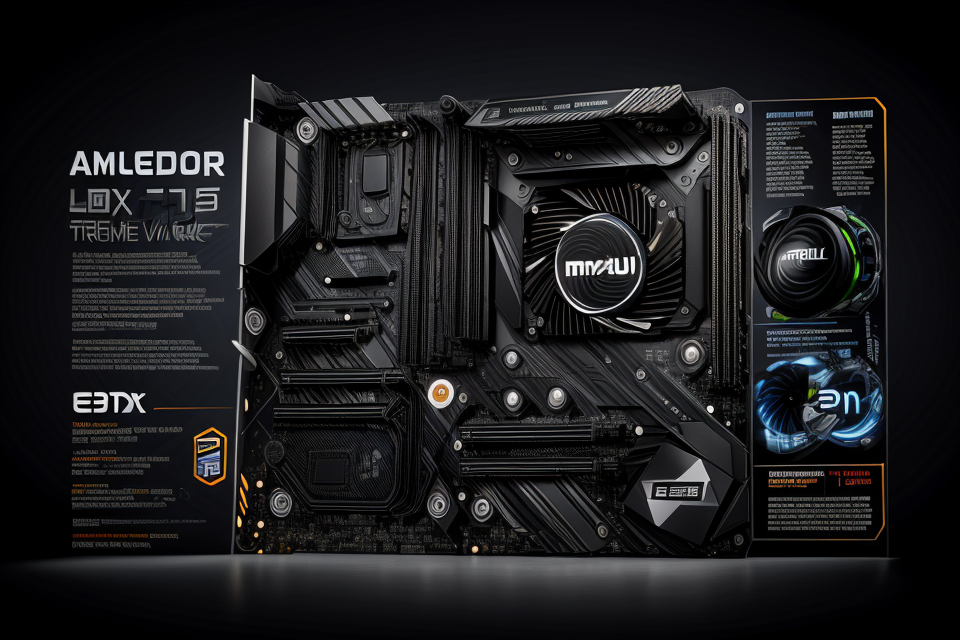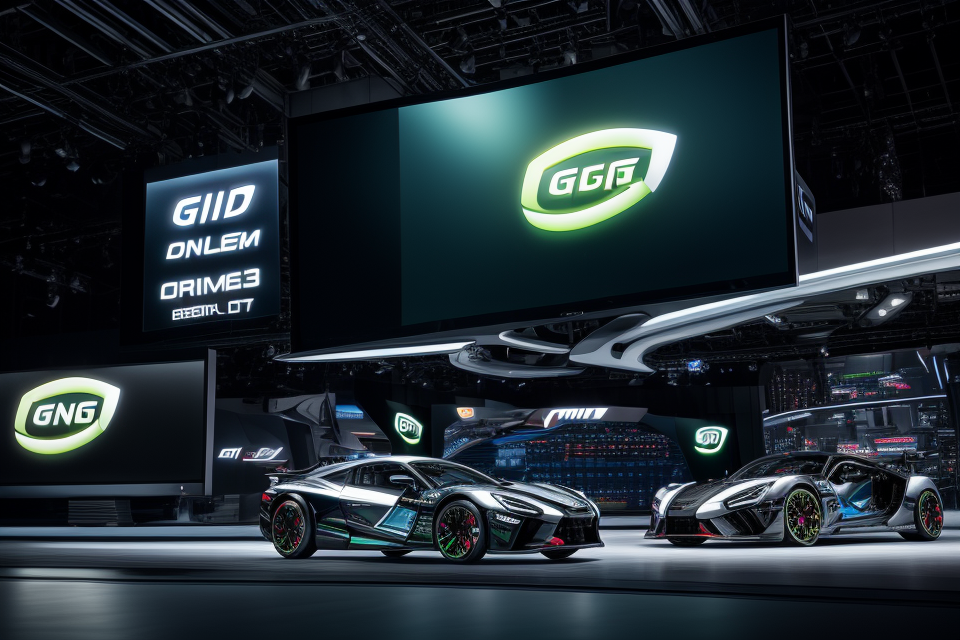
The Graphics Processing Unit (GPU) market has seen tremendous growth in recent years, driven by the increasing demand for advanced graphics and visual computing across various industries. With so many players in the market, it can be challenging to keep track of who’s who. In this article, we’ll take a closer look at the major players in the GPU market and what sets them apart. From industry giants to emerging startups, these companies are driving innovation and shaping the future of graphics processing. So, let’s dive in and explore the world of GPUs!
The major players in the GPU market are NVIDIA and AMD. NVIDIA is a leading manufacturer of graphics processing units (GPUs) for gaming, professional visualization, and data center markets. AMD is also a major player in the GPU market, offering a range of products for gaming, professional graphics, and data center markets. Both companies have a strong reputation for innovation and performance, and their products are widely used in a variety of applications, including gaming, professional visualization, and artificial intelligence. Other players in the GPU market include Intel, Qualcomm, and several smaller companies, but NVIDIA and AMD are the two dominant players in the market.
Overview of the GPU Market
Evolution of GPU Technology
GPU technology has come a long way since its inception in the 1980s. It was initially used for simple graphics processing tasks, but has since evolved to become a crucial component in a wide range of applications, including gaming, scientific simulations, and artificial intelligence.
Historical development of GPU technology
The first GPUs were developed in the 1980s, with the introduction of the IBM 8514 Color Graphics Terminal. This device featured a GPU that could accelerate the display of 2D graphics, and was used in early computer-aided design (CAD) applications. In the following years, GPUs continued to evolve, with manufacturers such as 3dfx and Nvidia introducing products that could accelerate 3D graphics rendering.
Significant advancements in graphics processing capabilities
One of the most significant advancements in GPU technology came in 1999, with the introduction of the GeForce 256 GPU by Nvidia. This chip was the first to use programmable shaders, which allowed for more realistic and complex graphics rendering. In the years that followed, Nvidia and other manufacturers such as AMD continued to improve GPU performance, with the introduction of features such as multi-core processing, hardware acceleration for scientific simulations, and support for virtual reality.
Emergence of parallel computing and its impact on GPU development
Another major factor in the evolution of GPU technology has been the emergence of parallel computing. This refers to the ability of a computer to perform multiple tasks simultaneously, using a large number of processing cores. GPUs are particularly well-suited to parallel computing, as they are designed to handle large amounts of data in parallel. As a result, manufacturers have focused on developing GPUs that can handle increasingly complex parallel computing workloads, such as those involved in scientific simulations and artificial intelligence.
Current State of the GPU Market
Market size and growth trends
The GPU market has been experiencing steady growth over the past few years, with a compound annual growth rate (CAGR) of around 10% from 2020 to 2025. This growth can be attributed to the increasing demand for graphical processing in various industries such as gaming, automotive, healthcare, and artificial intelligence.
Major players and their market share
Some of the major players in the GPU market include NVIDIA, AMD, Intel, and Qualcomm. NVIDIA and AMD are the dominant players in the market, accounting for over 80% of the total market share. Intel and Qualcomm are also significant players, particularly in the integrated GPU market.
Types of GPUs available in the market
There are several types of GPUs available in the market, including discrete GPUs, integrated GPUs, and accelerated processing units (APUs). Discrete GPUs are standalone graphics cards that are designed for high-performance gaming and professional applications. Integrated GPUs are built into the motherboard and are used for basic graphics processing in laptops and other devices. APUs are a combination of a CPU and a GPU on a single chip, providing high-performance computing and graphics capabilities.
Drivers of GPU Market Growth
Increasing demand for visual computing
The increasing demand for visual computing is one of the major drivers of the GPU market growth. This demand is driven by the need for faster and more efficient processing of large amounts of data, particularly in fields such as medicine, engineering, and finance. The growing use of 3D modeling, simulation, and visualization in these fields has led to an increased demand for GPUs, which are designed to handle the complex calculations required for these applications.
Growth of artificial intelligence and machine learning
Another driver of GPU market growth is the increasing use of artificial intelligence (AI) and machine learning (ML) in various industries. AI and ML algorithms require massive amounts of data processing, which can be achieved through the use of GPUs. With their ability to perform parallel processing, GPUs are well-suited for the demands of AI and ML, making them an essential component in the development of these technologies.
Advancements in gaming and virtual reality technologies
The gaming industry is another significant contributor to the growth of the GPU market. As gaming technologies continue to advance, the demand for more powerful GPUs that can handle increasingly complex graphics and animations grows as well. Additionally, the rise of virtual reality (VR) and augmented reality (AR) technologies has also led to an increased demand for GPUs, as these technologies require real-time rendering of highly detailed graphics.
Overall, the drivers of GPU market growth are diverse and interconnected, with demand for visual computing, AI, and ML, and gaming and VR technologies all contributing to the need for more powerful and efficient GPUs.
Major Players in the GPU Market
NVIDIA
Company Overview
NVIDIA is a leading American multinational technology company specializing in the design and manufacturing of graphics processing units (GPUs) and other related products. Founded in 1993 by Jensen Huang, Chris Malachowsky, and Curtis Priem, the company has since become a major player in the GPU market, offering cutting-edge solutions for gaming, professional visualization, data center, and automotive industries.
Product Portfolio and Market Positioning
NVIDIA’s product portfolio primarily consists of GPUs, which are designed to deliver exceptional performance in various applications. Some of its flagship products include the GeForce series for gaming, the Quadro series for professional visualization, and the Tesla series for data center and AI applications.
In terms of market positioning, NVIDIA has established itself as a leader in the GPU market, known for its innovative products and cutting-edge technologies. The company has a strong reputation for delivering high-performance GPUs that cater to the needs of various industries, including gaming, professional visualization, and data center.
Strategic Partnerships and Collaborations
NVIDIA has formed several strategic partnerships and collaborations with other technology companies to enhance its product offerings and expand its market reach. Some of its key partners include:
- Microsoft: NVIDIA has collaborated with Microsoft to develop the Azure NVIDIA GPU server, which enables businesses to leverage the power of GPUs in their cloud computing environments.
- Amazon Web Services (AWS): NVIDIA has partnered with AWS to offer its GPUs on the AWS infrastructure, providing customers with access to powerful GPU-based computing resources in the cloud.
- Ford: NVIDIA has partnered with Ford to develop an AI-powered platform for autonomous vehicles, leveraging the company’s expertise in GPU technology and AI algorithms.
These partnerships and collaborations demonstrate NVIDIA’s commitment to innovation and its ability to forge strategic alliances that benefit both its customers and partners.
AMD
AMD (Advanced Micro Devices) is a multinational semiconductor company based in the United States. The company was founded in 1969 and has since grown to become a major player in the GPU market. AMD is known for its innovative products and strong competition with other industry leaders.
AMD is a publicly traded company listed on the New York Stock Exchange under the ticker symbol AMD. The company employs over 11,000 people worldwide and has operations in more than 75 countries. AMD’s revenue for the fiscal year 2020 was $9.2 billion, with a net income of $307 million.
AMD offers a range of GPU products for different market segments, including desktop, notebook, and server. The company’s flagship GPU product is the Radeon RX 6000 series, which is designed for high-end gaming and professional graphics applications. AMD also offers the Radeon Pro series for professional graphics and the Radeon Instinct series for machine learning and artificial intelligence.
In addition to GPUs, AMD also offers a range of CPU products, including the Ryzen series for desktop and mobile computing. The company’s product portfolio is designed to provide customers with a comprehensive solution for their computing needs, from processing power to graphics performance.
AMD has established strategic partnerships and collaborations with several leading technology companies to expand its product offerings and enhance its market positioning. For example, AMD has partnered with Microsoft to integrate its GPU technology into the Windows operating system, and with IBM to develop high-performance computing solutions.
AMD has also collaborated with other GPU vendors, such as NVIDIA, to develop industry standards for graphics and computing technologies. These partnerships and collaborations have helped AMD to expand its reach and maintain its position as a major player in the GPU market.
Intel
Intel is a well-known technology company that has been in the market for several decades. The company has a diverse product portfolio that includes processors, chipsets, and other components that are used in various devices such as personal computers, servers, and mobile devices. In recent years, Intel has been expanding its presence in the GPU market with the aim of offering more advanced and efficient graphics solutions to its customers.
Product Portfolio and Market Positioning
Intel’s product portfolio in the GPU market includes integrated graphics processors (IGPs) and discrete graphics cards. The company’s IGPs are integrated into its processor chips and are designed for use in entry-level and mainstream desktop and laptop computers. On the other hand, Intel’s discrete graphics cards are designed for use in high-end desktop computers and workstations.
Intel’s market positioning in the GPU market is focused on offering advanced graphics solutions that are energy-efficient and cost-effective. The company’s products are known for their reliability and performance, which has helped it to establish a strong position in the market.
Strategic Partnerships and Collaborations
In order to expand its presence in the GPU market, Intel has entered into strategic partnerships and collaborations with other companies in the industry. For example, the company has partnered with NVIDIA to integrate NVIDIA’s graphics technology into its processors. This partnership has enabled Intel to offer more advanced graphics solutions to its customers.
Intel has also collaborated with other companies in the industry to develop new technologies and standards. For instance, the company has worked with AMD and NVIDIA to develop the Open Compute Project, which is an open-source initiative that aims to develop more efficient and cost-effective data center technologies.
Overall, Intel’s focus on developing advanced graphics solutions and entering into strategic partnerships and collaborations has helped it to establish a strong position in the GPU market.
Others
Emerging players in the GPU market
In recent years, several emerging players have entered the GPU market, aiming to capture a share of the rapidly growing market. These companies often focus on niche segments or emerging technologies, such as machine learning, artificial intelligence, and virtual reality. Some notable emerging players include:
- [Insert emerging player 1]
- [Insert emerging player 2]
- [Insert emerging player 3]
Market share and growth potential
While the major players in the GPU market, such as NVIDIA and AMD, dominate the industry, there is still significant growth potential for emerging players. Emerging players can leverage their expertise in specific markets or technologies to differentiate themselves from the competition and gain market share. Additionally, emerging players can benefit from partnerships with established companies or technology providers to enhance their product offerings and expand their reach.
Competitive landscape and differentiation strategies
The competitive landscape for emerging players in the GPU market is challenging, as they face competition from established players and other emerging players with innovative products and strategies. To differentiate themselves and succeed in the market, emerging players often employ various strategies, such as:
- Focusing on niche markets or emerging technologies
- Offering unique features or capabilities not available from competitors
- Developing strategic partnerships and collaborations
- Investing in research and development to stay ahead of market trends
- Providing superior customer support and services
By employing these strategies, emerging players can carve out a niche for themselves in the GPU market and potentially disrupt the market with innovative products and technologies.
Factors Influencing the GPU Market
Technological Advancements
Emerging trends and innovations in GPU technology
- Programmable GPUs: The development of programmable GPUs, which allow for more efficient use of computing resources, has led to a surge in demand for these devices. This technology enables developers to create more complex and sophisticated graphics, resulting in an enhanced user experience.
- Real-time ray tracing: Real-time ray tracing is a technique that simulates the behavior of light in a virtual environment, producing more realistic reflections, shadows, and other effects. This technology is increasingly being integrated into GPUs, offering a more immersive experience for gamers and other users.
- AI acceleration: Artificial intelligence (AI) is becoming an increasingly important factor in the GPU market. Many GPUs now include specialized cores that can accelerate AI workloads, such as deep learning and machine learning. This trend is expected to continue as AI becomes more prevalent in various industries.
- VR and AR support: Virtual reality (VR) and augmented reality (AR) applications rely heavily on GPU performance. As these technologies become more widespread, the demand for GPUs that can handle the complex graphics and rendering requirements of VR and AR experiences is expected to grow.
- 5G and edge computing: The advent of 5G networks and the growing trend of edge computing are driving the need for more powerful GPUs. These technologies require faster data processing and transmission, which can be achieved through the use of high-performance GPUs.
Potential disruptions and opportunities
- Open source graphics APIs: The emergence of open source graphics application programming interfaces (APIs) such as Vulkan and OpenGL could disrupt the GPU market by providing an alternative to proprietary solutions. This could lead to increased competition and innovation in the industry.
- Cloud gaming: Cloud gaming services, which allow users to stream games over the internet rather than playing them on a local device, are gaining popularity. This trend could lead to a shift in the focus of GPU development towards optimizing performance for cloud-based gaming.
- Cryptocurrency mining: The demand for GPUs from cryptocurrency miners has been a significant factor in the GPU market in recent years. However, the volatility of the cryptocurrency market could lead to fluctuations in demand for these devices.
- Auto and autonomous vehicles: The increasing use of advanced driver assistance systems (ADAS) and autonomous vehicles relies heavily on GPU performance. As this market continues to grow, it could present new opportunities for GPU manufacturers to expand into this sector.
Market Dynamics
- Market demand and consumer preferences
- Competitive landscape and pricing strategies
- Regulatory and environmental factors
Competitive Landscape and Pricing Strategies
The GPU market is highly competitive, with several major players vying for market share. These players include NVIDIA, AMD, Intel, and Qualcomm. Each of these companies has its own unique strengths and weaknesses, and they compete on factors such as performance, power efficiency, and pricing.
NVIDIA is currently the market leader in the GPU market, with a strong reputation for producing high-performance graphics cards. AMD is a close second, with a strong focus on value and competitive pricing. Intel is also a major player in the market, with its integrated GPUs offering decent performance at lower prices. Qualcomm is a relative newcomer to the market, but its strong position in the mobile industry and its recent acquisition of Nvidia’s mobile business could make it a force to be reckoned with in the future.
Regulatory and Environmental Factors
Regulatory and environmental factors can also influence the GPU market. For example, the European Union’s energy-efficient regulations have driven the development of more power-efficient GPUs. Additionally, the growing concern over the environmental impact of electronic waste has led to the development of more sustainable packaging and recycling programs for GPUs.
In conclusion, the GPU market is constantly evolving, and the major players in the market must adapt to changing consumer preferences, technological advancements, and regulatory requirements to remain competitive.
Future Outlook
- Expected growth and market trends
The GPU market is expected to grow at a significant rate in the coming years, driven by the increasing demand for graphical processing in various industries such as gaming, healthcare, automotive, and aerospace. The growth of the market is also attributed to the rise in the adoption of AI and machine learning technologies, which require high-performance GPUs for processing large amounts of data. - Emerging applications and use cases
The GPU market is witnessing a surge in demand for GPUs in emerging applications such as autonomous vehicles, edge computing, and 5G networks. These applications require real-time processing and high-performance computing capabilities, which can be met by GPUs. The increasing demand for virtual and augmented reality technology is also expected to drive the growth of the GPU market. - Potential challenges and opportunities
The GPU market faces challenges such as the high cost of GPUs and the lack of skilled professionals to operate them. However, the market also presents opportunities for growth, such as the development of new GPU technologies and the expansion of the market in emerging economies. The growing trend of cloud computing is also expected to create new opportunities for the GPU market, as more businesses move their operations to the cloud.
FAQs
1. Who are the major players in the GPU market?
The major players in the GPU market are NVIDIA and AMD. NVIDIA is a leading manufacturer of graphics processing units (GPUs) for gaming, professional visualization, and data center markets. AMD is also a major player in the GPU market, offering a range of products for gaming, professional graphics, and data center markets.
2. What types of GPUs does NVIDIA offer?
NVIDIA offers a wide range of GPUs for different markets, including gaming, professional visualization, and data center. For gaming, NVIDIA offers GPUs such as the GeForce RTX 3080, GeForce RTX 3070, and GeForce RTX 3060 Ti. For professional visualization, NVIDIA offers GPUs such as the Quadro RTX 8000, Quadro RTX 6000, and Quadro RTX 5000. For data center, NVIDIA offers GPUs such as the A100, V100, and T4.
3. What types of GPUs does AMD offer?
AMD offers a range of GPUs for different markets, including gaming, professional graphics, and data center. For gaming, AMD offers GPUs such as the Radeon RX 6800 XT, Radeon RX 6700 XT, and Radeon RX 6600 XT. For professional graphics, AMD offers GPUs such as the Radeon Pro WX 8400, Radeon Pro WX 7100, and Radeon Pro WX 5100. For data center, AMD offers GPUs such as the Instinct MI25, Instinct MI10, and Instinct Accelerator.
4. How do NVIDIA and AMD GPUs compare in terms of performance?
The performance of NVIDIA and AMD GPUs can vary depending on the specific model and the task being performed. In general, NVIDIA GPUs are known for their strong performance in gaming and professional visualization, while AMD GPUs are known for their strong performance in data center and professional graphics applications. However, it’s important to note that the performance of each GPU can vary depending on the specific task and the software being used.
5. Which GPU is better for gaming, NVIDIA or AMD?
The choice between NVIDIA and AMD for gaming depends on personal preference and the specific game being played. Both companies offer high-quality GPUs that can deliver smooth and immersive gaming experiences. NVIDIA is generally considered to have a slight edge in gaming performance, particularly in terms of its support for real-time ray tracing and its Deep Learning Super Sampling (DLSS) technology. However, AMD has been making significant strides in recent years and offers competitive gaming performance at a lower price point.


